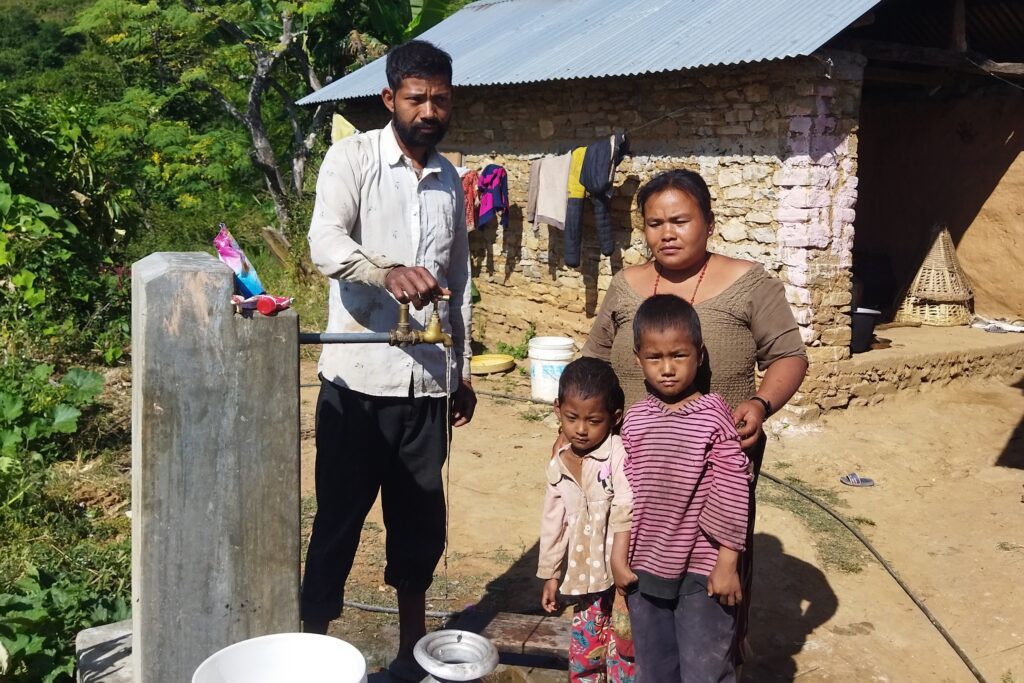Sindhuli district, located in Nepal, has long struggled with water scarcity. Following the devastating 2015 earthquake, many natural water springs disappeared, and the district began to experience prolonged droughts. Outdated water supply systems were insufficient to meet the community’s growing needs, with many residents walking over 30 minutes to collect water from distant taps and local schools had no water supply at all.
Against this backdrop, Karuna Shechen launched the Drinking Water Supply Scheme (DWSS) to provide reliable access to clean water for both the local school and surrounding households.
In the early stages of the project
In Search of Clean Water
The need for an efficient, reliable, and sustainable water supply is a critical priority. Before the DWSS, Sindhuli’s outdated dilapidated water supply system could barely meet basic needs. Families depended on water taps shared among multiple households.
Sunil Pokharel, Field Technical Officer, explains the emergency of the situation:
“The old water supply schemes were not fully functioning. The pipes leaked, storage capacity was reduced and water sources were shrinking. There was no specific water supply system at the school, which holds more than 190 students and 12 staff members, so sanitation and hygiene were very poor.”
The initiative was set up to provide easy access to clean water to households, students and staff of Janata Basic School (in Bhirgaun, ward number 6).
Clean water for all
The primary objectives of the Drinking Water Supply Scheme were clear and urgent:
- Securing a reliable water source that could provide a consistent supply throughout the year
- Ensuring sufficient water supply to meet the daily needs of both households and the school, safeguarding the community’s right to water
- Providing clean drinking water to reduce waterborne diseases and improve public health
- Improving accessibility by installing one tap per household, making water collection easier and faster
- Enhancing sanitation and hygiene practices at both household and school levels, moving towards total sanitation in the community.
The DWSS is also a long-term investment in the health, education, and economic well-being of Sindhuli’s residents, laying the foundation for a more resilient community.
Building together
The shared effort of the community
Excited by the prospect of a new water supply system, the community actively united around the project.
Sunil is pleased with the work achieved through collective effort:
“The local community was eager to take part in the search for a new water source. They conducted meetings and contributed as much as they could by gathering local materials such as sand, stones, and labor. In fact, the community covered 45% of the total project cost.”


A real sense of ownership has been established within the community, motivating its members to actively engage and make contributions. This strengthened bond between residents has played an essential role in the success of the project, fostering collaboration and mutual support.
Sustainable technologies
To ensure long-term sustainability, the project used simple yet effective engineering solutions. A gravity-flow system was constructed to transport water from a protected spring to an 8,000-liter reservoir tank, built using Ferro Cement technology. Water is then conveyed through high-density polyethylene (HDPE) pipes to household and school taps. Flow regulators and water meters ensure the taps provide a steady supply of water, while cable crossings were installed to carry the pipes across deep valleys and rocky terrain. This approach ensured a reliable water supply that requires minimal maintenance and upkeep.



Overcoming Challenges
During the implementation of the project, the team faced significant challenges as Sunil mentions: “We faced several challenges, including the unavailability of hardware materials, lack of transportation facilities, and difficult terrain where pipe burying wasn’t possible. But through teamwork, we overcame these hurdles.”
Indeed, to address these issues, the team coordinated with local suppliers and used tractors to transport materials over a 30-kilometer earthen road.
An impact that changes lives
The installation of the DWSS has had a significant impact on the health of the communities, it has also permitted time savings and the creation of economic opportunities.

With clean water now available at household taps, women no longer suffer from back pain due to carrying heavy water containers over long distances. They can focus on other activities, such as taking care of their families or engaging in income-generating work like kitchen gardening. Indra Bahadur Bishowkarma, a resident of Phikkal Rural Municipality in Sindhuli, testifies to this change: “The availability of drinking water changed our lifestyle. We now have enough water for us and our livestock. We’ve also started a kitchen garden using wastewater, and we planted some orange trees that we water with it.”
His wife recounts the difficulties of the past: “In the past, I had to travel far to fetch drinking water early in the morning, carrying one child while leaving the other at home, as my husband had to work in the fields. It was a very hard time for us.”
In addition to reducing the daily burden on women, access to water has also promoted better hygiene practices within the community. This contributes to overall well-being and creates a healthier learning environment. Raising awareness of the importance of hygiene plays an essential role in reducing the risk of waterborne diseases.


The DWSS had a profound impact on the daily lives of the villagers of Bhirgaun. With reliable access to clean water, families, students and staff at Janata Basic School now enjoy better living and hygiene conditions. By leveraging sustainable technologies and community involvement, this project embodies a concrete example of a solidarity and sustainable initiative, serving a better future for all.
